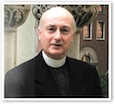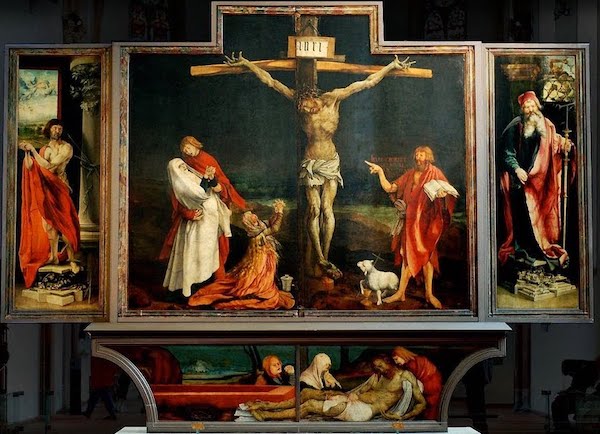The Isenheim Altarpiece
- FATHER GEORGE W. RUTLER
I knew an elderly Scotswoman who read the Bible each night by the light of a candle.
It had become a kind of ritual, for everyone needs a rite, including those reared in the stark Calvinist kind of worship of her homeland Kirk. While she did all of her other reading by electric light, the lamp was turned off and the candle lit for the Bible. It was by that burning taper that she could read, as all of us can, the wonderful and mysterious words: "I am the light of the world. Whoever follows me will not walk in darkness, but will have the light of life" (John 8:12).
That contrast of light and dark is powerfully depicted in the Isenheim Altarpiece now in Colmar, France. It was produced between 1512 and 1516 by the sculptor Nikolaus of Haguenau and painter Matthias Grünewald for a hospital that treated people suffering from skin diseases, and such affliction is depicted on the flesh of the Crucified Christ in what has been called "The most beautiful painting of ugliness in the history of art." The darkness of the Passion is darker for being next to the incandescent light of the Risen Christ. At the foot of the Cross, in deliberate contempt for chronology, is John the Baptist, still alive and attended by a lamb, for John had called his cousin "the Lamb of God, who takes away the sins of the world" (John 1:29). The Lamb, a symbol of Christ sacrificed on the cross, is also the Light that pre-existed all created light as we know it. "And the city has no need for sun or moon to shine on it, because the glory of God illuminates the city, and the Lamb is its lamp" (Revelation 21:23).
That illuminating "glory of God" briefly broke through created light as we know it in the Transfiguration. If it is to be understood to some small degree, that will be by acknowledging the "pre-existence" of Christ: "He was in the beginning with God. All things came into being through him, and without him not one thing came into being" (John 1:2-3).
Even in speech, the mystery of Christ's pre-existence declares itself: ". . . before Abraham was, I am" (John 8:58). For any human confined to chronology, saying that would be using bad grammar. One might say "I was" (Simple Past), "I was existing" (Past Continuous), "I had existed" (Past Perfect), or "I had been existing" (Past Perfect Continuous), but only Christ can defy grammar by saying that before Abraham was, "I am."
John — standing at the Jordan river, poorly dressed and even more poorly fed — employed the only grammar available to him, to declare of his younger cousin: "This is he, of whom I said: After me there comes a man who is preferred before me, because he was before me" (John 1:30).
Faithfully yours in Christ,
Father George W. Rutler
 This is Meaghen Gonzalez, Editor of CERC. I hope you appreciated this piece. We curate these articles especially for believers like you.
This is Meaghen Gonzalez, Editor of CERC. I hope you appreciated this piece. We curate these articles especially for believers like you.
Please show your appreciation by making a $3 donation. CERC is entirely reader supported.

Acknowledgement
 Father George W. Rutler. "The Isenheim Altarpiece." From the Pastor (January 19, 2020).
Father George W. Rutler. "The Isenheim Altarpiece." From the Pastor (January 19, 2020).
Reprinted with permission of Father George W. Rutler.
The Author
 Father George W. Rutler is the pastor of St. Michael's church in New York City. He has written many books, including: The Wit and Wisdom of Father George Rutler, The Stories of Hymns, Hints of Heaven: The Parables of Christ and What They Mean for You, Principalities and Powers: Spiritual Combat 1942-1943, Cloud of Witnesses — Dead People I Knew When They Were Alive, Coincidentally: Unserious Reflections on Trivial Connections, A Crisis of Saints: Essays on People and Principles, Brightest and Best, and Adam Danced: The Cross and the Seven Deadly Sins.
Father George W. Rutler is the pastor of St. Michael's church in New York City. He has written many books, including: The Wit and Wisdom of Father George Rutler, The Stories of Hymns, Hints of Heaven: The Parables of Christ and What They Mean for You, Principalities and Powers: Spiritual Combat 1942-1943, Cloud of Witnesses — Dead People I Knew When They Were Alive, Coincidentally: Unserious Reflections on Trivial Connections, A Crisis of Saints: Essays on People and Principles, Brightest and Best, and Adam Danced: The Cross and the Seven Deadly Sins.





